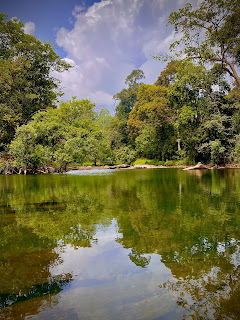Sinna Dorai, Valparai: Misty mountains, tea gardens and a walk on the wild side...
When someone first said that I must visit Sinna Dorai near Valparai, I must confess I had never heard of it. I had never even heard of Valparai, a small hill station in the Annamalai Range in Tamil Nadu. I’ve been to several tea estates in Assam and Sri Lanka while Bangalore itself has the coffee country of Coorg and Chikmagalur a few hours drive away. As a result, I thought I knew what to expect. A pretty estate. Good home style food. Relaxing walks. Estates are always beautiful but if you’ve been to enough of them they are also very familiar in a good way.
Sinna Dorai, however, was unlike any estate I’ve ever been to. Not only was it more beautiful than almost any estate I’ve ever been to, it was also wilder and more untouched than I could ever have imagined. Our cottage was visited by a bear a few weeks ago, while the estate itself is home to elephants and Gaur and martens and mongoose and some of the rarest birds you can ever find including the Great Indian Hornbill. We got a sense of how this place combines nature and wildlife on the drive up from Pollachi when we stumbled across a highly endangered Nilgiri Tahr at the side of the road, followed a few kilometres later by a group of Lion Tailed Macaques swinging through the trees.
The bungalow itself is located deep inside Paralai Estate, famous for its organic teas and one of the Crown Jewels of the Murugappa Group which took over the plantations in the area from the British Cooperative Wholesale Society a few years after I was born. The bungalow itself was used by the managers of the estate as their home for decades, dating back to almost a century ago, and you can see the difference between a hotel and a home that has been looked after with love and pride for decades. Even our cottage had history attached to it. It was built in 1931 and hosted Karver Marsh, the man who explored the wild Annamalai mountains and started the first tea plantains there in the early part of the twentieth century.
It is enough just to sit and have a cup of tea and see the mist roll by and the hills turn different shades of green as the sun traverses the deep blue sky, occasionally hiding behind a wisp of cloud as a cool breeze brushes against your skin. Sunsets that look like an Impressionist painting. In the evening you can drive around the plantation with the staff, where you don’t need too much luck to see an owl soaring majestically or a civet scurrying across the grass, like we did. I could spend days doing that and I only wish I was a poet or artist or writer because this place provides a deep well of inspiration.
However, thanks to the management at Sinna Dorai, we got to experience things that really went beyond the finest tea estates. Sinna Dorai in Valparai is managed by Meenu Nair, who lived in the home till 2001. She commandeered the managers and team across the neighbouring plantations to give us access to experiences that aren’t available publicly. We spent time with the conservationists and scientists of Nature Conservation Foundation (NCF) who have spent decades ensuring we study and protect our wildlife heritage from Ladakh to Arunachal Pradesh to Valparai. We drove to Murugalli Estate an hour away, where the manager Mr. Bobby took us to visit streams and lakes and water bodies that were created through the backwaters of the Sholayar Dam. These are places that are truly untouched, accessible only through private roads in the estates and in the middle of real wilderness, places where elephants come to drink and frolic and where a leopard’s sawing cough lead to a cacophony of panicked Nilgiri langurs, places that feel like you’ve stepped into a chapter of Kipling’s Jungle Book. And when we were finally ready to leave the forest, Mr. Bobby took us for a Malayalee meal to his home perched on the mountain peak, overlooking a carpet of green like an eagle surveying its domain.
Let me be very clear. Sinna Dorai is not a “luxury holiday”. It’s not a Glenburn Tea Estate. While it does offer the same creature comforts, this is a place that is rawer, wilder and more thrilling, a place that you go to when you want to leave the urban jungle behind. Go and visit.. its rare to be one of the first to discover a place that’s truly special and this is a place that will get very well known very soon.
Ps: Some of the creatures we saw on the trip, that too without a professional naturalist.
- Nilgiri Tahr
- Jungle Cat
- Gaur
- Barking Deer
- Wild Boar
- Nilgiri Langur
- Bonnet Macaque
- Lion Tailed Macaque
- Brown Mongoose
- Indian Grey Mongoose
- Common Palm Civet (it looked more like a Brown Palm Civet but that’s so hard to spot that I am sceptical we were that lucky)
- Indian Hare
- Giant Malabar Squirrel
- Peacocks
- Indian Grey Hornbill
- Brown Fisher Owl
- Serpent Eagle
- Grey Heron
- Several kinds of Egrets
- Malabar Whistling Thrush
- Golden Backed Woodpecker
- Several kinds of Bee-Eaters
- Common Kingfisher
- Parakeets








Comments